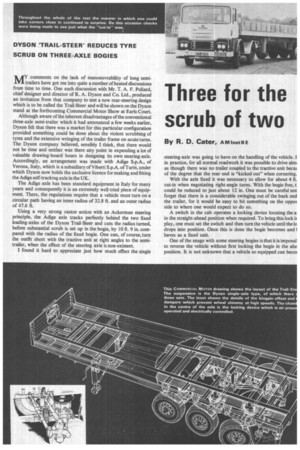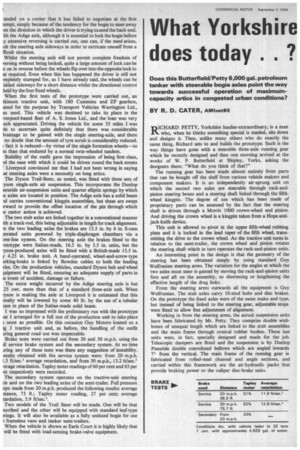Three for the scrub of two
Page 53

Page 54

If you've noticed an error in this article please click here to report it so we can fix it.
By R. D. Cater, AMInstBE MY comments on the lack of manoeuvrability of long semitrailers have got me into quite a number of heated discussions from time to time. One such discussion with Mr. T. A. F. Pollard, chief designer and director of R. A. Dyson and Co. Ltd., produced an invitation from that company to test a new rear-steering design which is to be called the Trail-Steer and will be shown on the Dyson stand at the forthcoming Commercial Motor Show at Earls Court.
Although aware of the inherent disadvantages of the conventional three-axle semi-trailer which it had announced a few weeks earlier, Dyson felt that there was a market for this particular configuration provided something could be done about the violent scrubbing of tyres and the extensive wringing of the trailer frame on acute turns. The Dyson company believed, sensibly I think, that there would not be time and neither was there any point in expending a lot of valuable drawing-board hours in designing its own steering-axle. Accordingly, an arrangement was made with Adige S.p.A., of Verona, Italy, which is a subsidiary of Viberti S.p.A. of Turin, under which Dyson now holds the exclusive licence for making and fitting the Adige self-tracking axle in the UK.
The Adige axle has been standard equipment in Italy for many years and consequently it is an extremely well-tried piece of equipment. There, the regulations require that a vehicle must turn on a circular path having an inner radius of 32.8 ft. and an outer radius of 47.6 ft.
Using a very strong castor action with an Ackerman steering principle, the Adige axle tracks perfectly behind the two fixed leading-axles of the Dyson Trail-Steer and cuts the radius turned, before substantial scrub is set up in the bogie, by 10 ft. 9 in. compared with the radius of the fixed bogie. One can, of course, turn the outfit short with the tractive unit at right angles to the semitrailer, when the effect of the steering axle is non-existent.
I found it hard to appreciate just how much effect the single steering-axle was going to have on the handling of the vehicle. 1 in practice, for all normal roadwork it was possible to drive aim as though there was no trailer coupled to the tractive unit becai of the degree that the rear end is "kicked out" when cornering.
With the axle fixed it was necessary to allow for about 4 ft. cut-in when negotiating right-angle turns. With the bogie free, t could be reduced to just about 12 in. One must be careful not forget that there is a considerable swinging out of the back end the trailer, for it would be easy to hit something on the oppos side to where one would expect to do so.
A switch in the cab operates a locking device locating the a: in the straight-ahead position when required. To bring this lock ii play, one must set the switch and then turn the vehicle until the lo drops into position. Once this is done the bogie becomes and I haves as a fixed unit.
One of the snags with some steering bogies is that it is impossil to reverse the vehicle without first locking the bogie in the ahe position. It is not unknown that a vehicle so equipped can hem :anded on a corner that it has failed to negotiate at the first tempt, simply because of the tendency for the bogie to steer away nri the direction in which the driver is trying tasend the back-end. ith the Adige axle, although it is essential to lock the bogie before Ly extensive reversing is carried out, one can, if the need arises, rsh the steering axle sideways in order to extricate oneself from a fficult situation.
Whilst the steering axle will not permit complete freedom of versing without being locked, quite a large amount of lock can be it on in reverse before the wheels flip over into the opposite lock to at required. Even when this has happened the driver is still not impletely stumped for, as I have already said, the wheels can be iddecl sideways for a short distance whilst the directional control held by the four fixed wheels.
When the first tests of the prototype were carried out, an tkinson tractive unit, with 180 Cummins and ZF gearbox, aned for the purpose by Transport Vehicles Warrington Ltd., as used. This vehicle was destined to take its place in the Lverpool-based fleet of A. S. Jones Ltd., and the loan was very uch appreciated. Driving the vehicle for some 35 miles I was )1e to ascertain quite definitely that there was considerable ivantage to be gained with the single steering-axle, and there no doubt that the amount of tyre scrub is considerably reduced. I fact it is reduced—by virtue of the single formation wheels—to ss than that endured by a normal twin-wheeled tandem.
Stability of the outfit gave the impression of being first class, id the ease with which it could be driven round the back streets Liverpool convinced me that I had not been wrong in saying at steering axles were a necessity on long artics.
The Dyson Trail-Steer, as tested, was fitted with three sets of yson single-axle air suspension. This incorporates the Dunlop neuride air-suspension units and quarter elliptic springs by which le axles are located in position. The Adige axle has a solid beam id carries conventional kingpin assemblies, but these are swept irward to provide the offset location of the pin through which le castor action is achieved.
The two stub axles are linked together in a conventional manner ith a track-rod, this being adjustable in length for track alignment. m the two leading axles the brakes are 15.5 in. by 6 in. S-cam perated units powered by triple-diaphragm chambers via a tree-line system. On the steering axle the brakes fitted to the rototype were Italian-made, 16.5 in. by 3.5 in. units, but the lyson-produced axles will be fitted with a British-made 15.5 in. y 4.25 in. brake unit. A hand-operated, wheel-and-screw-type arking-brake is finked by Bowden cables to both the leading ties. On the production vehicles, standard Dyson hub and wheel luipment will be fitted, ensuring an adequate supply of parts in ie event of accident, damage or failure.
The extra weight incurred by the Adige steering axle is but ,25 cwt. more than that of a standard three-axle unit. When lyson is making the axle at Liverpool it is estimated that this malty will be lowered by some 40 lb. by the use of a tubular 3am in place of the Italian-made solid beam.
I was so impressed with the preliminary run with the prototype at I arranged for a full test of the production unit to take place soon as possible. On this occasion Guy Motors loaned us a ig .1 tractive unit and, as before, the handling of the outfit aring general road use was impeccable.
Brake tests were carried out from 20 and 30 m.p.h. using the ill service brake system and the secondary system. At no time iring any of these tests was there any suggestion of instability. esults obtained with the service system were: from 20 m.p.h. 1.3 ft/sec.' average retardation, and from 30 m.p.h., 13.2 ti/sec.2 rerage retardation. Tapley meter readings of 60 per cent and 65 per :nt respectively were recorded.
The secondary system operates on the tractive-unit steering de and on the two leading axles of the semi-trailer. Full pressure ops made from 20 m.p.h. produced the following results: average stance, '73 ft.; Tapley meter reading, 27 per cent; average tardation, 5.9 ft/sec.'.
Two models of the Trail Steer will be made. One will be that :scribed and the other will be equipped with standard leaf-type wings. It will also be available as a fully unitized bogie for use frameless vans and tanker semi-trailers.
When the vehicle is shown at Earls Court it is highly likely that will be fitted with load-sensing brake-valve equipment.
































































































































